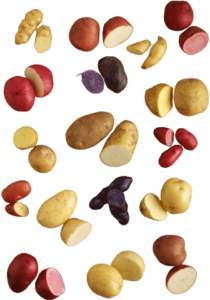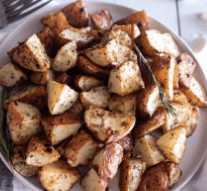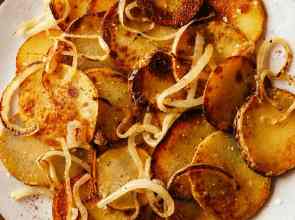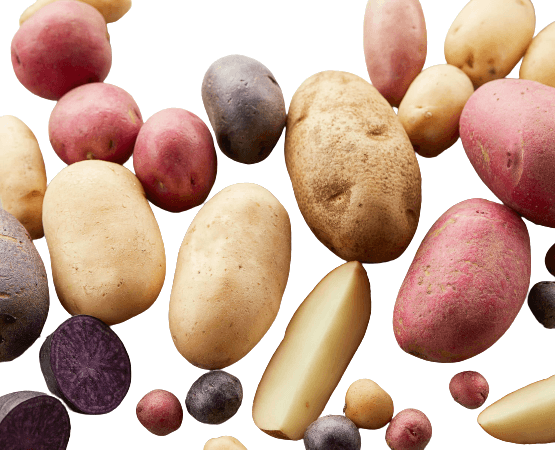Are potatoes vegetables?
The Potato is one of the most used and important plant families of mankind which includes the nightshade family.
In the world of culinary delights and healthy living, potatoes vegetables hold a special place.
It is not only a staple in many cuisines but also a powerhouse of nutrition.

Potatoes, often misunderstood as just a source of carbs, are actually packed with nutrients.
A medium-sized potato provides nearly half of the daily recommended intake of vitamin C, and it’s also a good source of vitamin B6, potassium, and fiber.
The fiber content aids digestion, while potassium helps regulate blood pressure.
Starchy vegetables and grains are two completely different food groups that play
distinctly different roles in contributing nutrients to the diet.
Unlike grains, potatoes are nutrient-dense and a strong contributor of fiber.
The suggestion to reclassify potatoes as non-vegetable is not based on any scientific metric.
Potatoes do not have the same nutritional profile as other vegetables such as lettuce, tomatoes and carrots.
Potatoes are definitely a vegetable.
It comes from an annual plant grown for its edible root. According to the USDA, vegetables are classified into five subgroups based on their nutritional content.
Vegetables are “the edible part of a plant,” and tubers like potatoes fit that description. Botanically, potatoes are only vegetables because there is no other category for them.
Unlike green vegetables, potatoes contain starch that can raise blood sugar levels.
The World Health Organization (WHO) also excludes potatoes from the vegetable category, and the UK’s Eatwell Guide classifies potatoes as a starchy carbohydrate, along with bread, rice and pasta.
Simple potatoes vegetables recipe
Red potatoes for roasting
Red potatoes are packed with lots of flavor and always get rave reviews from family and friends.
Red potatoes are crispy on the outside, soft and fluffy on the inside, making these roasted red potatoes a regular favorite of yours.
Red potatoes are great when roasted in the oven. This type of potato keeps its shape well and has a neutral flavor that goes well with the spices of this dish. These types of potatoes have different shapes and sizes.
These Roasted Red Potatoes are packed to absolute perfection, with garlic, herbs and this crispy filling for all tastes.
Cut your potatoes in half, then toss them in a mixture of olive oil, dried herbs, garlic, Parmesan cheese, and seasonings.
Place potatoes in a single layer on a sheet pan.
Roast until the potatoes are golden brown and tender, about 35-40 minutes.
Sprinkle the cooked potatoes with fresh parsley, then serve and enjoy.
Potatoes soften as they cool.
Any leftovers will stay fresh in the fridge for up to 3 days.
You can reheat your potatoes until crispy on the stove top or in the oven.
Use freshly grated parmesan cheese, it makes a big difference in the final result.
You can use other spices to mix it up a bit, such as Cajun seasoning, a little cayenne pepper for heat, smoked paprika, or even chili powder.
Taste variety
This dish is great as is, but you can add other flavors to customize it to your taste.
Potatoes: Don’t have red potatoes? Yukon gold or fingerling potatoes can be used instead.
Herbs: Instead of parsley, you can use fresh chopped dill, chives or basil.
Cheese: Like your potatoes extra cheesy? Add a handful of shredded mozzarella or cheddar cheese during the last 5 minutes of baking.
Vegetables: You can add some vegetables to the roasting pan such as carrots, parsnips, red onions or Brussels sprouts.
Flavor: Sprinkle some extra flavor into your baked potatoes by adding cooked potatoes, olives, or sun-dried tomatoes.
Protein: Add chicken apple sausage or pan-cooked sausage like kielbasa.
Potatoes and onions fried
Roasted potatoes and onions are a classic combination with countless variations. This is the simplest and a variation that involves fried potatoes and onions.
What is the secret of fried potatoes and onions?
Perfect Roasted Potatoes and Onions This recipe requires patience, not rushing the process.
It is cooked on too high a heat or the onions and potatoes are stirred too frequently. If the heat is set too high, the potatoes will burn before they are fully cooked on the outside, and turning them too soon or too often will prevent the potatoes from forming a nice golden brown crust on the bottom.
Waxy potatoes, such as russet potatoes, Yukon Gold, yellow, Idaho, or baby potatoes, which have a firmer texture, will do.
Ingredients for baked potatoes and onions
Potatoes and onions are coated in butter, oil, and spices for a crispy-tender potato side dish you’ll want to repeat. To make Roasted Potatoes and Onions you will need:-
Vegetable oil: helps achieve potatoes with a crispy texture. Feel free to substitute with other high smoke point oils if desired.
Salted Butter: Adds flavor and richness.
Russet Potato: Russet is a starchy potato that roasts beautifully with a soft interior and crispy exterior. You can also use Yukon gold or red potatoes if needed.
Black Pepper and Kosher Salt: Enhances the taste of food.
Garlic Powder: Adds a savory, aromatic quality to potatoes and onions.
Onions: Adds sweetness, depth and an onion flavor that pairs well with potatoes.
How to Make baked potatoes and onions
Made on the stovetop in less than 30 minutes, these roasted potatoes and onions are so easy to put together, you’ll be making them for breakfast, lunch, and dinner. Full instructions are below, but here’s a quick overview before you get started:
Step 1. Heat oil and butter: Heat oil and butter in a large skillet over medium-high heat. Add potatoes and toss to coat.
Step 2. Add remaining ingredients: Cover and cook for 5 minutes. Add remaining ingredients.
Step 3. Cook 15 to 20 minutes, uncovered, turning potatoes every 5 minutes, until tender and browned.
Baked potatoes and onions variation
For a colorful and flavorful result, consider these additions:
Vegetables: Add chopped bell peppers or mushrooms for extra texture, color and flavor.
Fresh herbs: Finish the dish with a sprinkling of fresh parsley, chives or thyme.
Cheese: Melt shredded cheddar or Monterey jack toward the end of cooking, or finish the dish with grated Parmesan.
Sausage or Bacon: Add sausage or bacon to the mix for a savory, salty addition.
Heat: Serve with chili flakes, hot sauce, or a sprinkle of Sriracha for a spicy kick.
Greens: Add fresh spinach at the end of cooking for a nutrient-rich addition.
Eggs: Serve with a fried egg for the ultimate breakfast.
Planting potato
How long does it take to grow potatoes?
Germination begins in 15 – 30 days and shoots emerge after planting. Plants at this stage produce flowers (white, purple, or pink) reaching maturity 90-120 days after emergence. Potatoes are ready to cut.
What is the best time to sow potatoes?
The first is planted in early – late March.
Second Early – Plant in early to mid-April.
Main crop – Seedlings in mid to late April.
Is a potato a flowering plant or not?
Potatoes are in the Solanaceae family, also known as the nightshade family. The beautiful purple flowers that grow from potato plants are a good reminder that potatoes are the family members of eggplant, peppers, and tomatoes.
What is the distance between potato plants?
You can grow potatoes in your home garden.
Spacing: 8″ – 12″ in-row x 24″ – 36″ between rows. If large storage potatoes are your goal space plant as far as 20” away. Plant potatoes in 3- to 5-inch deep cuts.
What is the lifespan of a potato plant?
Cultivated potato (Solanum tuberosum) has a relatively short lifespan of 70 to 150 days from planting to maturity. Its developmental stages are often described in terms of tuber germination, vegetative development, tuber initiation, tuber bulking and finally plant emergence.
How many potatoes per plant in the garden?
You can expect at least five to six new potatoes for each potato planted. If every tree counts like this! There’s something magical about pulling up a potato plant and seeing lots of new potatoes attached to the little potatoes you planted months ago.
What is the best soil for potatoes?
Sandy soil is best for growing potatoes in the home garden.
Potatoes grow best in sandy soils. Poorly drained soil is more likely to produce diseased tubers. Test your soil. The ideal soil pH level for potatoes is slightly acidic, between 6 and 6.5, but they will tolerate soil with a pH of less than 5.
References:
https://www.southernliving.com/
https://barefeetinthekitchen.com/
